Russell Gladabout
When the Russell Gladabout made its debut in October 1944, it may well have been the first all-new postwar automobile. Such a grand distinction would have been wasted on an ordinary car, and so Ray Russell did not waste his opportunity.
An industrial designer possessing an active mind and artist’s soul, Russell appreciated those who took risks while making practical things beautiful. He admired futurist Buckminster Fuller’s work with dynamic design. He owned one of the nine revolutionary 1936 Stout Scarab streamlined minivans built by his friend William Stout. Even his Detroit home was designed by architectural pioneer Frank Lloyd Wright. Like those other visionaries, Ray did not do things in a conventional way. His Gladabout car, which he hoped to sell for well under $1000, makes this abundantly clear.
Ray Russell and his Gladabout
The Gladabout was actually Russell’s third attempt at producing an automobile. The first was a plastic bodied car he built in 1941. The body was actually made of ethyl cellulose spread over wire mesh. Placed on a new Chevrolet chassis, it was designed as a practical solution to looming wartime steel shortages. But Ray could find no investors willing to bet on this precursor to fiberglass. A year later Ray was back, showing what looked like a very different car but was likely the same Chevy underneath. This time the body was made of wood. He employed 2 layers of plywood bonded together with some of the ethyl cellulose left over from his earlier prototype. He claimed that the end result was as strong as steel, while eliminating the need for expensive dies or presses. Investors, however, were unmoved by Ray’s woody.
For his third offering, he turned to aluminum for a smoothly sculpted body. It was designed for simplicity and low cost, comprising of just 4 panels stretched over not a ’41 Chevy but a much smaller British MG chassis. The MG’s original 80in wheelbase was retained, but it was widened to allow for 3-across seating. (This brings to mind Webster’s Dictionary entries that never were. Gadabouting, v. Three people driving around while squished together)
While the space between the Gladabout’s axles was very short, this was made up for at each end with very long overhangs. Such a feature allowed Gadabout owners the option of specifying whether they wanted their engine mounted in front of the front wheels or behind the back ones. Why anyone would want such a choice remains a mystery to all but Ray Russell. Nevertheless, such flexibility was made possible by the fact that the Gadabout had no axles or transmission. The two drive wheels, whether in front or in back, had a small motor in each hub that was driven by oil pressure from the engine’s crankshaft. Said engine was also quite advanced. The air-cooled two-stroke unit had direct fuel injection, and what may well be the first application of a turbocharger in an American car.
Popular Science and Mechanics Illustrated magazines, in separate pieces on the Gladabout, both hailed this technological tour de force with some variation of, “the car of tomorrow today.” Unfortunately, the little runabout never made it out of yesterday. Only one was ever made before Ray Russell was hired by the Kaiser-Frazer Corporation to work on yet another alternative material, this time an experimental resin body for a low cost small car that never saw the light of day. Sadly, the only Russell Gladabout ever made does not appear to have survived.
Copyright@2023 by Mal Pearson

